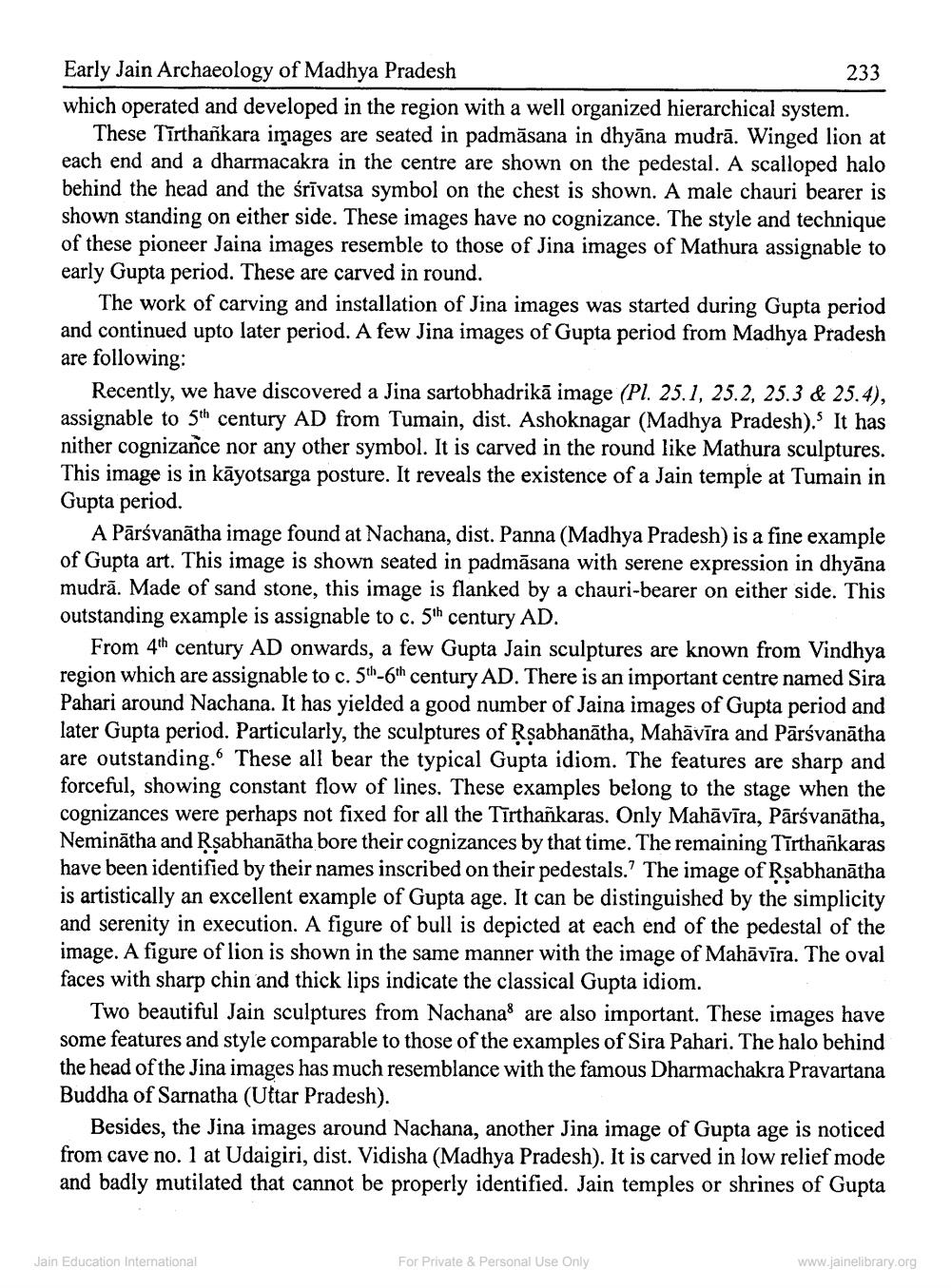________________
Early Jain Archaeology of Madhya Pradesh
233 which operated and developed in the region with a well organized hierarchical system.
These Tīrthañkara images are seated in padmāsana in dhyāna mudrā. Winged lion at each end and a dharmacakra in the centre are shown on the pedestal. A scalloped halo behind the head and the śrīvatsa symbol on the chest is shown. A male chauri bearer is shown standing on either side. These images have no cognizance. The style and technique of these pioneer Jaina images resemble to those of Jina images of Mathura assignable to early Gupta period. These are carved in round.
The work of carving and installation of Jina images was started during Gupta period and continued upto later period. A few Jina images of Gupta period from Madhya Pradesh are following:
Recently, we have discovered a Jina sartobhadrikā image (Pl. 25.1, 25.2, 25.3 & 25.4), assignable to 5th century AD from Tumain, dist. Ashoknagar (Madhya Pradesh). It has nither cognizance nor any other symbol. It is carved in the round like Mathura sculptures. This image is in kāyotsarga posture. It reveals the existence of a Jain temple at Tumain in Gupta period.
A Pārsvanātha image found at Nachana, dist. Panna (Madhya Pradesh) is a fine example of Gupta art. This image is shown seated in padmāsana with serene expression in dhyāna mudrā. Made of sand stone, this image is flanked by a chauri-bearer on either side. This outstanding example is assignable to c. 51h century AD.
From 4th century AD onwards, a few Gupta Jain sculptures are known from Vindhya region which are assignable to c. 5th-6th century AD. There is an important centre named Sira Pahari around Nachana. It has yielded a good number of Jaina images of Gupta period and later Gupta period. Particularly, the sculptures of Rsabhanātha, Mahāvīra and Pārsvanātha are outstanding. These all bear the typical Gupta idiom. The features are sharp and forceful, showing constant flow of lines. These examples belong to the stage when the cognizances were perhaps not fixed for all the Tīrthañkaras. Only Mahāvīra, Pārsvanātha, Neminātha and Rsabhanātha bore their cognizances by that time. The remaining Tīrthañkaras have been identified by their names inscribed on their pedestals. The image of Rsabhanātha is artistically an excellent example of Gupta age. It can be distinguished by the simplicity and serenity in execution. A figure of bull is depicted at each end of the pedestal of the image. A figure of lion is shown in the same manner with the image of Mahāvīra. The oval faces with sharp chin and thick lips indicate the classical Gupta idiom.
Two beautiful Jain sculptures from Nachanas are also important. These images have some features and style comparable to those of the examples of Sira Pahari. The halo behind the head of the Jina images has much resemblance with the famous Dharmachakra Pravartana Buddha of Sarnatha (Uttar Pradesh).
Besides, the Jina images around Nachana, another Jina image of Gupta age is noticed from cave no. 1 at Udaigiri, dist. Vidisha (Madhya Pradesh). It is carved in low relief mode and badly mutilated that cannot be properly identified. Jain temples or shrines of Gupta
Jain Education International
For Private & Personal Use Only
www.jainelibrary.org




